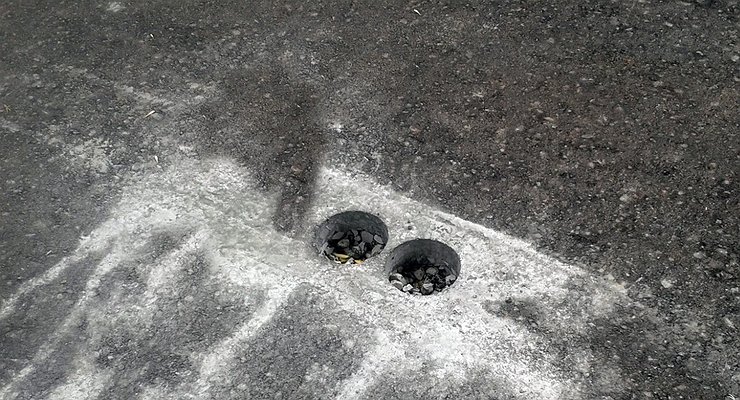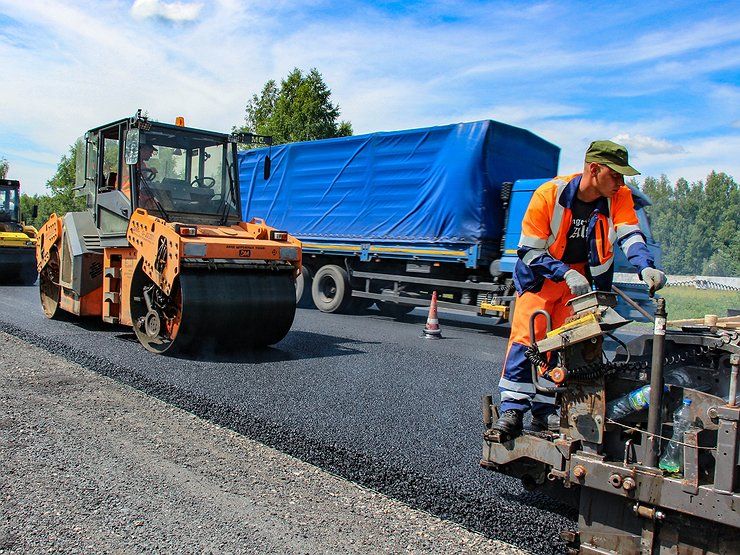Why do we need strange, differently shaped holes on freshly laid asphalt?
- August 3, 2022
- 0
Many motorists have noticed that after laying the new asphalt, strange holes or stripes appear in it. There can be several in a row, and they can be
Many motorists have noticed that after laying the new asphalt, strange holes or stripes appear in it. There can be several in a row, and they can be

What kind of holes are drilled in the newly laid asphalt? A vital necessity or a deliberate sabotage, so that holes appear more quickly and a new pecuniary order for re-laying asphalt breaks out? Or else why aren’t they sealed? Well, if there are questions, there are answers.
Let’s start with the fact that round holes or elongated strips are called cores. And their purpose is very important when laying new asphalt. The point is that road builders monitor the quality of laying the road surface in this way – cores after cutting are sent directly to the laboratory to study the thickness and quality of the material.
Rectangular cores are cut with a special seam cutting tool. And round holes remain from the core sampler, which cuts the asphalt into small cylinders.
As a rule, cores are drilled in the first three days after the asphalt is laid – when it is warm and warm and already rolled with a roller. Cold lane samples are taken after 15-30 days. Depending on the surface and composition of the asphalt, the diameter of the clearings also varies. So, for example, when laying sand-asphalt concrete, the core diameter should be at least 50 mm. If the asphalt is fine-grained, then 70 mm. For a coarse-grained road – all 100 mm.
Having discovered the appearance of holes in the asphalt, we will now find out whether the holes and rectangular recesses that remain after sampling should be sealed. As a rule, motorists, driving on a new road, usually see core samples until the end of the life of the constructed road.
Remember what rectangular recesses look like – their edges are flattened by loads and temperatures. And in winter, when there is a constant drop in temperature and full of moisture, such cores turn into a pit. All this on the basis that yes – the cores must be sealed immediately, immediately after sampling. To do this, road builders need to use “cold asphalt” – a mixture of bitumen, a special solvent and stone (holes in old asphalt are repaired in the same way).
It’s even good if the monster digs are covered with gravel. And meanwhile, if the holes in the asphalt are not repaired, they can cause accidents with motorcyclists, cyclists and other two-wheelers, with more and more of them on summer roads every year.

What kind of holes are drilled in the newly laid asphalt? A vital necessity or a deliberate sabotage, so that holes appear more quickly and a new pecuniary order for re-laying asphalt breaks out? Or else why aren’t they sealed? Well, if there are questions, there are answers.
Let’s start with the fact that round holes or elongated strips are called cores. And their purpose is very important when laying new asphalt. The point is that road builders monitor the quality of laying the road surface in this way – cores after cutting are sent directly to the laboratory to study the thickness and quality of the material.
Rectangular cores are cut with a special seam cutting tool. And round holes remain from the core sampler, which cuts the asphalt into small cylinders.
As a rule, cores are drilled in the first three days after the asphalt is laid – when it is warm and warm and already rolled with a roller. Cold lane samples are taken after 15-30 days. Depending on the surface and composition of the asphalt, the diameter of the clearings also varies. So, for example, when laying sand-asphalt concrete, the core diameter should be at least 50 mm. If the asphalt is fine-grained, then 70 mm. For a coarse-grained road – all 100 mm.
Having discovered the appearance of holes in the asphalt, we will now find out whether the holes and rectangular recesses that remain after sampling should be sealed. As a rule, motorists, driving on a new road, usually see core samples until the end of the life of the constructed road.
Remember what rectangular recesses look like – their edges are flattened by loads and temperatures. And in winter, when there is a constant drop in temperature and full of moisture, such cores turn into a pit. All this on the basis that yes – the cores must be sealed immediately, immediately after sampling. To do this, road builders need to use “cold asphalt” – a mixture of bitumen, a special solvent and stone (holes in old asphalt are repaired in the same way).
It’s even good if the monster digs are covered with gravel. And meanwhile, if the holes in the asphalt are not repaired, they can cause accidents with motorcyclists, cyclists and other two-wheelers, with more and more of them on summer roads every year.
Source: Avto Vzglyad
I’m Sandra Torres, a passionate journalist and content creator. My specialty lies in covering the latest gadgets, trends and tech news for Div Bracket. With over 5 years of experience as a professional writer, I have built up an impressive portfolio of published works that showcase my expertise in this field.